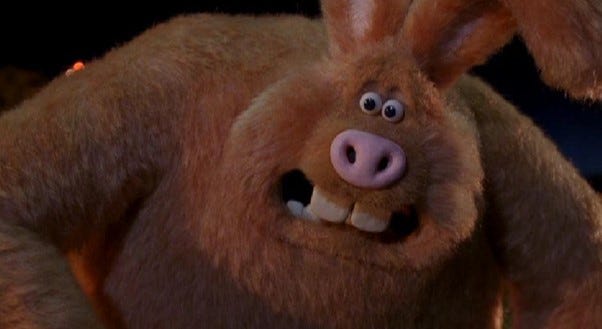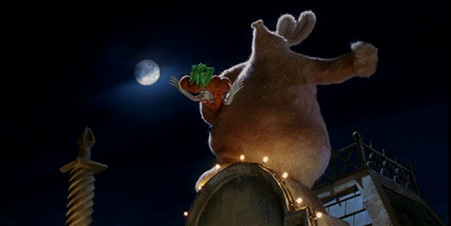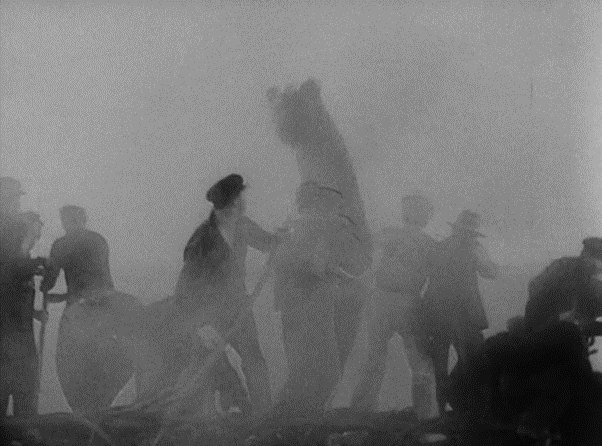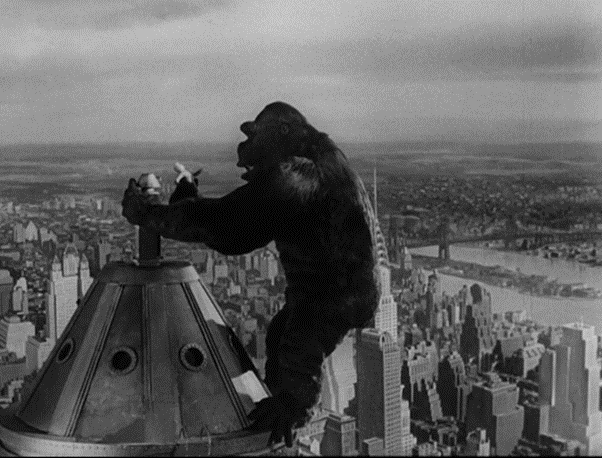Beastly Men and Manlike Monsters – King Kong and the Were-Rabbit
Horror Moments, Wallace and Gromit Edition
‘Horror Moments’ is a light-hearted series examining horror-inflected scenes and themes in unexpected places. The ‘moments’ are published weekly on Thursday mornings, and I share bonus content on the history of magic, theatre, storytelling, and more on Monday afternoons – don’t forget to subscribe!
[Spoilers: Wallace and Gromit: Curse of the Were-Rabbit (2005), American Werewolf in London (1981), King Kong (1993)]
Alright, brace yourselves and please imagine the following:
So there’s a rabbit with the brain of a man driving a van behind which a giant marrow (with a dog on top) is being dragged to lure a mutant rabbit monster away from a vegetable competition. Meanwhile, a meanspirited trigger-happy fortune seeker who is hoping to shoot the beast with a golden bullet hastily fashioned from a carrot-shaped trophy, is arguing with the lady of the manor, herself dressed as a carrot.
Got that?
Victor Quartermaine (said fortune-seeking villain) is trying to wrest the trophy from Lady Tottington’s hands when the were-rabbit stops and pauses his pursuit of the marrow. He hears her cries for help and turns —
For a moment we see the suggestion of humanity, of empathy and love, but then its eyes narrow and its nostrils flare. It knocks Victor on the head and seizes up Lady Tottington, smashing his way through the vegetables.
Chased by an angry mob, it leaps onto the side of Tottington Manor and in an instant Wallace, in were-rabbit form, has assumed the iconic appearance of King Kong, the ‘Eighth Wonder of the World’.
Before I watched the original King Kong (1933) I was sceptical about whether I’d enjoy it and certainly whether it counted as a horror film. Watching it for this article, I was won over on both counts.
Kong began life as a straightforward ‘big scary monster’ with creator Merian C. Cooper calling the film a “giant terror gorilla picture.” Kong and the other giants that stalk Skull Island are genuinely menacing. The water dinosaur is particularly sinister, rising from the mist and picking the men off one by one.
Death throughout the film is slow and grisly. One particularly protracted sequence sees Kong tearing open a dinosaur’s mouth and toying with its limp remains.
The special effects somehow still hold up (though the race and gender politics certainly don’t), most surprising is the pathos conjured from a giant stop-motion gorilla. Kong is a genuinely sympathetic antagonist, and his demise is a bittersweet conclusion motivated by something like love for the ‘golden’ Ann Durrow. The famous final line “It was beauty killed the beast,” casts doubt on how ‘beastly’ Kong was all along.
In King Kong, the relative threats of man and beast are made explicitly clear. In the first scene the hubristic film director Carl Denham is trying to persuade a talent agent to let one of his actresses join him for a mysterious shoot on a far-off island. When asked about the danger he replies “and I suppose there’s no danger in New York? Listen, there are dozens of girls in this town tonight that are in more danger than they’ll ever see with me.”
In Were-Rabbit, Wallace in rabbit form is infinitely preferable to the scheming Victor whose gold-digging desire for Lady Tottingham puts her in far more danger than she’ll ever see with the fluffy suitor who gently places her inside her rooftop greenhouse just as Kong puts Ann down tenderly on the roof of the Empire State Building.
Unlike King Kong, Were-Rabbit has a happy ending: Wallace is revived and all is put right with the world. The scheming Victor undergoes an opposite transformation: chased away by villagers inside a were-rabbit costume. Both films, however, use the pathos of a beauty/beast relationship to emphasise the villainy of ordinary men with monstrous intentions.
Join me next Thursday for another Horror Moment. Happy nightmares everyone!
Horror moments are posted every Thursday and a wide variety of articles exploring the history of magic, theatre, storytelling, and more are published on Monday afternoons.







Look forward to more “King" themed for film critique... The King and I? The King's Speech? King Lear?
Your exploration of the parallels between King Kong and Were-Rabbit was clever and thought-provoking. I loved how you drew connections between the two films while highlighting the human villainy in each. It’s refreshing to see such a light-hearted take on horror moments. Great piece.